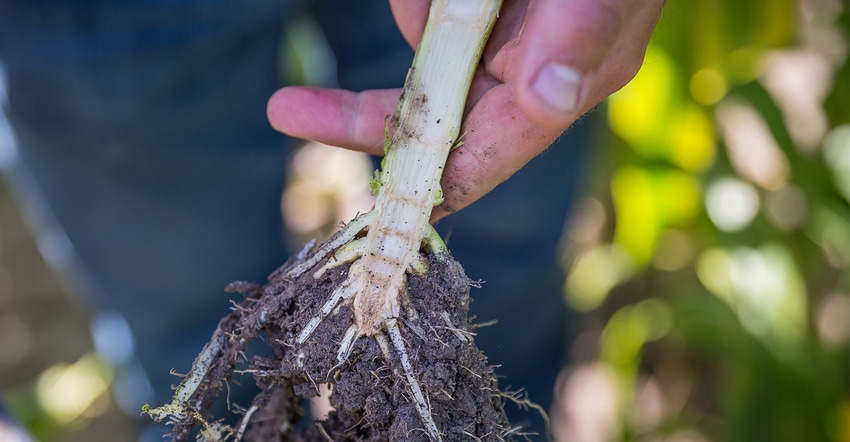June 30, 2020

Peak corn rootworm egg hatch for central Iowa began occurring on June 18 based on accumulating degree days. “Since then, we’ve had no trouble finding rootworm larvae in refuge corn, with rootworms ranging from a quarter to a half inch in length,” says Erin Hodgson, Iowa State University Extension entomologist. “They were very active [wiggly] today.”
Hodgson offers these guidelines for corn rootworm scouting:
Dig time. Dig an 8-inch soil cube around a corn plant. Collect several plants per field, especially if using multiple hybrids per field.
Larva check. You have two options to check for the presence of larvae in the soil cubes you dig:
Place the sample on a black plastic garbage bag and break apart soil. The small white larvae should show up on contrasting black background.
Place the soil cube in a 5-gallon bucket with water and break the soil apart. This is sometimes referred to as the “float test.” Agitate the soil cube in the bucket of water, and the rootworm larvae should float to top of the water.
Characteristics. Corn rootworm has three instars or growth stages. Usually you can see second and third instars using both methods — either using the plastic bag or the “float test” to look for the tiny rootworm larvae. The larvae have slender bodies and are cream-colored; they have a dark head and dark plate at the end of the abdomen and have three pairs of thoracic legs.
An economic threshold for larvae has not been established, but their presence serves as an indicator of potential yield losses due to injury while feeding on corn roots. It’s a “red flag” if you see more than three larvae per plant when you are checking the roots, says Hodgson says.
Continue to monitor the field for adult corn rootworm beetle emergence (during or after corn plant silking) to make management decisions for future growing seasons. Estimate the amount of root injury from larvae when adults are present.
Egg hatch has late start
Corn rootworm egg hatch got a late start in Iowa this year. In Iowa, rootworm egg hatch occurs from late May to the middle of June, with an average peak hatching date of June 6 in central Iowa. In 2020, the hatching date is behind the average due to cool spring temperatures. Development is driven by soil temperature and measured by growing degree days.
Research suggests about 50% of egg hatch occurs between 684 to 767 accumulated degree days (base 52 degrees F, soil). Most areas in Iowa this year reached peak corn rootworm egg hatch in the middle of June.
A severe corn rootworm larval infestation can destroy Nodes 4 to 6; each node has about 10 nodal roots. Root pruning interferes with water and nutrient uptake, and make the plant unstable. A recent analysis showed a 15% yield loss for every node pruned back to 1 to 5 inches.
Regardless of agronomic practices used to suppress corn rootworm (such as crop rotation, planting Bt corn hybrids or using soil-applied insecticides), every field should be scouted for corn rootworm root injury, Hodgson says. Continuous cornfields and areas with Bt trait performance issues are the highest priority for inspection. Looking at corn roots 10 to 14 days after peak egg hatch is encouraged because the feeding injury will be fresh.
She says you should assess corn plants in your fields for corn rootworm feeding and adjust your management strategies if the average injury is above 0.5 on the ISU “zero to 3” Node Injury Scale. Also, consider monitoring for adult corn rootworm to supplement root injury assessments. Aaron Gassmann, ISU corn research entomologist, has a webpage for additional corn rootworm management information including an interactive node-injury scale demonstration and efficacy evaluations.
Read more about:
RootwormAbout the Author(s)
You May Also Like






